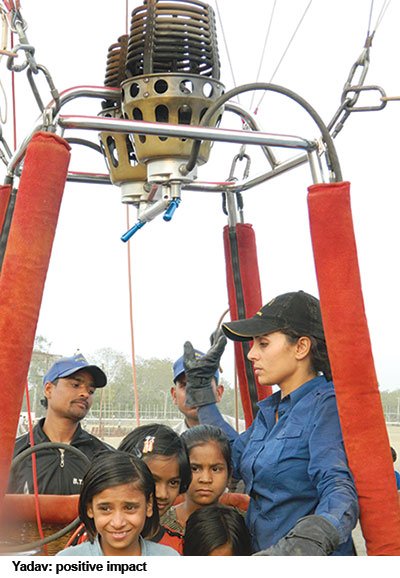New vistas for hot air balloon pilots
With the global adventure tourism industry recording double digit growth rates annually, ballooning has re-emerged as a new and highly rewarding 21st century career – Paromita Sengupta

The hot air balloon has flown a long way since its maiden flight manned by two Frenchmen soared 3,000 ft over Paris in the 18th century. Three centuries later it has re-emerged as a popular flying machine used the world over to provide thrilling adventure and entertainment experiences.
Commercial hot air balloons are lighter-than-air aircraft comprising a bag (aka envelope) made of fire-resistant material that holds heated air. Suspended beneath is a ‘gondola’ or wicker basket to accommodate passengers, and a source of heat. In most cases, an open flame ignited by burning liquid propane or LPG is used. Unlike hot air balloons driven by the wind, thermal airships can be propelled through the air.
Latter day ballooning in India is a fair weather winter months activity for tourists, advertisers eager to promote their products and air balloon enthusiasts with a yen to view the world from on high. Licensed balloon pilots (mainly freelancers) are hired by adventure tourism companies and advertisers. They require intensive training and licensing as they are responsible for the safety of passengers, flight-path decisions, crew and equipment, and flight records.
The adventure tourism industry which has recorded significant growth (17 percent CAGR) globally and is projected to attain a revenue of $13 billion (Rs.9,100 crore) by 2023, has revived and boosted the ballooning business worldwide.
Study programmes
To qualify as a hot air balloon pilot, aspirants over 18 years of age are eligible to apply to balloon flight training schools in the UK/US/Europe. As yet, formal balloon flight training schools haven’t sprung up in India.
To meet the civil aviation ministry’s testing standards for hot air ballooning, flight schools offer study programmes in practical knowledge and flight instruction. The syllabus covers subjects such as meteorology, airmanship, navigation, flight rules, codes of conduct, pre and post-flight procedures, balloon manoeuvres, emergency procedures and knowledge of basic civil aviation regulations. After logging a minimum 35 hours flying time as a light airplane pilot, 20 hours flying time in balloons, six hours flying time with a flight instructor, two solo flights, two flights of over one hour, and one flight over 5,000 ft, candidates are ready for a final flight test and certification by an examiner.
Foreign licence holders are required to write a composite exam conducted by the Delhi-based Director General of Civil Aviation (DGCA).
Pay & perks
Hot air balloon pilots in India are usually paid according to the number of flights logged during a season. Freshers (co-pilots) can expect Rs.30,000-60,000 per month with pay packages rising to Rs.1-2 lakh per month for experienced pilots. Advertisers who hire balloons and the services of their owners (usually pilots) tend to pay Rs.80,000-1.5 lakh per season.
Balloon rides don’t come cheap and can cost up to Rs.2,000-3,000 per adult for a 15-minute joy ride.
Professional progression
“Rising awareness of the thrill of adventure sports and substantial growth of the adventure tourism industry globally, has positively impacted the ballooning business worldwide, India included. Given India’s diverse topography and rich cultural heritage, I believe there is endless scope for adventure tourism in our country. With a growing number of private tourism companies such as Sky Waltz, Tiger Balloon Safaris, Deccan Airsports, and state government ministries investing in heritage tour time charters, employment opportunities are abundant,” says Bangalore-based Rita Yadav, India’s second certified hot air balloon pilot and also the first licensed Indian airship pilot certified by the civil aviation authority of the UK.
Inspired by her husband Col. M.K. Yadav, also a hot air balloon pilot, para-trooper, sky diver and mountaineer, Rita began her career in aviation in 2001. For over six years, she worked with her sister-in-law Anita Yadav, India’s first hot air balloon pilot. In 2007, Rita took a bank loan to invest in her own balloon which cost her Rs.30 lakh, and went freelance, offering balloon services to public and private corporates. In 2009, she signed up with the south Goa-based Camping Retreats of India Pvt. Ltd (aka Tiger Balloon Safaris) and is the company’s official pilot. Now a master trainer, Yadav has also held workshops for cadets of the National Defence Academy, Khadakvasla.
“India has too few certified balloon pilots. My dream is to start India’s first balloon flight training school and give youth the benefit of this offbeat highly rewarding profession. I am awaiting government sanction,” she says.
Institutes that offer training include:
















Add comment